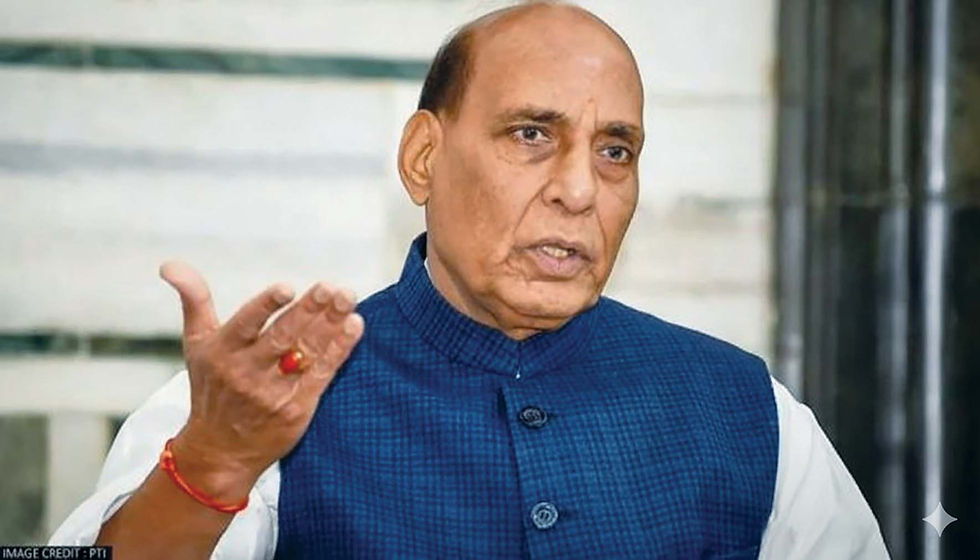The General’s Republic: Decoding Pakistan’s Security State
- Commodore S.L. Deshmukh

- Apr 21
- 4 min read
A deep dive into Pakistan’s national security strategy reveals an ambitious doctrine rooted in paranoia, prestige, and a powerful military-industrial complex.

“The art of war,” Sun Tzu wrote, “is a matter of life and death, a road either to safety or to ruin.” In few countries is this aphorism more apt than in Pakistan. Since its bloody partition from India in 1947, the Islamic republic has defined its national identity through militarisation and rivalry with its larger neighbour. But while India evolved into a boisterous, if flawed, democracy, Pakistan morphed into a security state dominated by its armed forces - a leviathan that casts a long shadow over its polity, economy and diplomacy.
Unlike most modern militaries, the Pakistan Armed Forces are not merely an instrument of state: they are, in many ways, the state itself. Civilian governments have been repeatedly toppled or manipulated by Rawalpindi’s khaki-clad elite. The military establishment controls the national narrative, corporate empires and the political class. From staging coups to installing pliant leaders, the army has been Pakistan’s preeminent power broker since independence.
This military dominance stems from the deep-rooted hostility towards India. The three wars fought with India in 1947, 1965, and 1971 (the last culminating in the loss of East Pakistan, now Bangladesh) have left psychological scars that shape Islamabad’s defence posture to this day. India’s conventional military superiority, nuclear arsenal and growing investment in disruptive technologies have prompted Pakistan to double down on deterrence, hybrid warfare and regional alliances.
In 2022, Pakistan, for the first time in its history, published a National Security Policy (NSP), a document that attempts to articulate a comprehensive framework beyond the traditional India-centric military doctrine. Though couched in the language of ‘citizen security’ and ‘human development,’ the document ultimately betrays the paranoia of the Establishment. It outlines threats across five domains: land, sea, air, cyber and space, mirroring the ambitions of far larger economies.
The NSP speaks of deterrence and stability, but its subtext is unmistakable: strategic parity with India is non-negotiable. Hence, it emphasises the development of nuclear and conventional capabilities, including an upgrade in cyberspace infrastructure, the protection of critical infrastructure from hostile surveillance, and the need to adapt to hybrid warfare. The nod to non-traditional security issues may be novel, but the mindset remains vintage Cold War.
Dragon’s Embrace
Pakistan’s military posture is also a product of international patronage. Initially armed and funded by the United States during the Cold War, Pakistan later pivoted to China after relations with the West soured. The 1963 Sino-Pakistan agreement was a turning point. Since then, Beijing has become Islamabad’s principal arms supplier, strategic partner and collaborator in everything from missiles to space technology. Pakistan’s nuclear and space capabilities have benefited greatly from Chinese assistance, creating a defence partnership that now resembles an alliance in all but name.
Even as Washington designated Pakistan a major non-NATO ally in 2004 to secure its cooperation in Afghanistan, the bulk of Islamabad’s arms came from China, with auxiliary support from France, Turkey and Italy. With its procurement diversified and its defence manufacturing capabilities increasingly indigenous (often in collaboration with Beijing), Pakistan has ensured it is not strategically beholden to any single benefactor.
The scale of Pakistan’s military apparatus is vast. Its active army consists of roughly 560,000 personnel, with another 550,000 in reserve. The army is equipped with over 2,600 main battle tanks (many jointly developed with China) and a host of artillery systems, rocket launchers and air defence networks sourced from across the globe. Electronic warfare capabilities, communication infrastructure and surveillance tools add further muscle. The Pakistan Army Aviation Wing operates around 300 helicopters, with a fixed-wing fleet of about the same size, including attack, surveillance, and transport aircraft.
The Navy and Air Force, while smaller, have ambitions to punch above their weight, especially as maritime security gains prominence in the Arabian Sea. The Strategic Plans Division Force (SPD), which manages Pakistan’s nuclear assets, reports directly to the powerful Joint Chiefs of Staff Committee (JCSC), headed by Gen. Sahir Shamshad Mirza. The JCSC oversees a sprawling inter-services bureaucracy that includes the notorious Inter-Services Intelligence (ISI), long accused of fomenting cross-border militancy and proxy warfare in Kashmir and Afghanistan.
Deep State
Yet, what makes Pakistan’s armed forces unique is not just their battlefield strength, but their commercial empire. Through foundations like the Fauji Foundation and the Army Welfare Trust, the military controls vast holdings in banking (e.g., Askari Bank), construction, telecommunications, and even agriculture. This military-corporate nexus blurs the line between national defence and private enrichment, and ensures that the military’s interests are deeply embedded in every aspect of Pakistani society.
The dual role of warfighter and kingmaker has given rise to a political paradox. The army projects itself as the guardian of national integrity, even as it routinely subverts democratic institutions. Civilian leaders, including Nawaz Sharif and Imran Khan, have found themselves on the wrong side of the generals once their popularity threatened military supremacy.
For India, the evolution of Pakistan’s military and strategic doctrine is a reminder of the hard-edged realism that must guide policy.
Yet India must also be cautious not to mirror Pakistan’s militarisation. Unlike its neighbour, India remains a democracy with constitutional safeguards and a vibrant civil society. Preserving that distinction while remaining vigilant may be its greatest long-term strategic advantage. For India, understanding the contours of Pakistan’s security state is a necessary starting point. But victory, in this enduring rivalry, may ultimately lie in winning peace, not just preparing for war.
(The writer is a naval aviation officer and geopolitical analyst. Views personal)





Comments